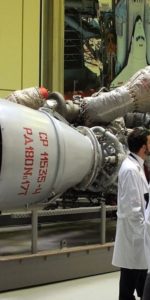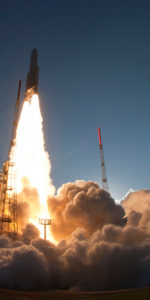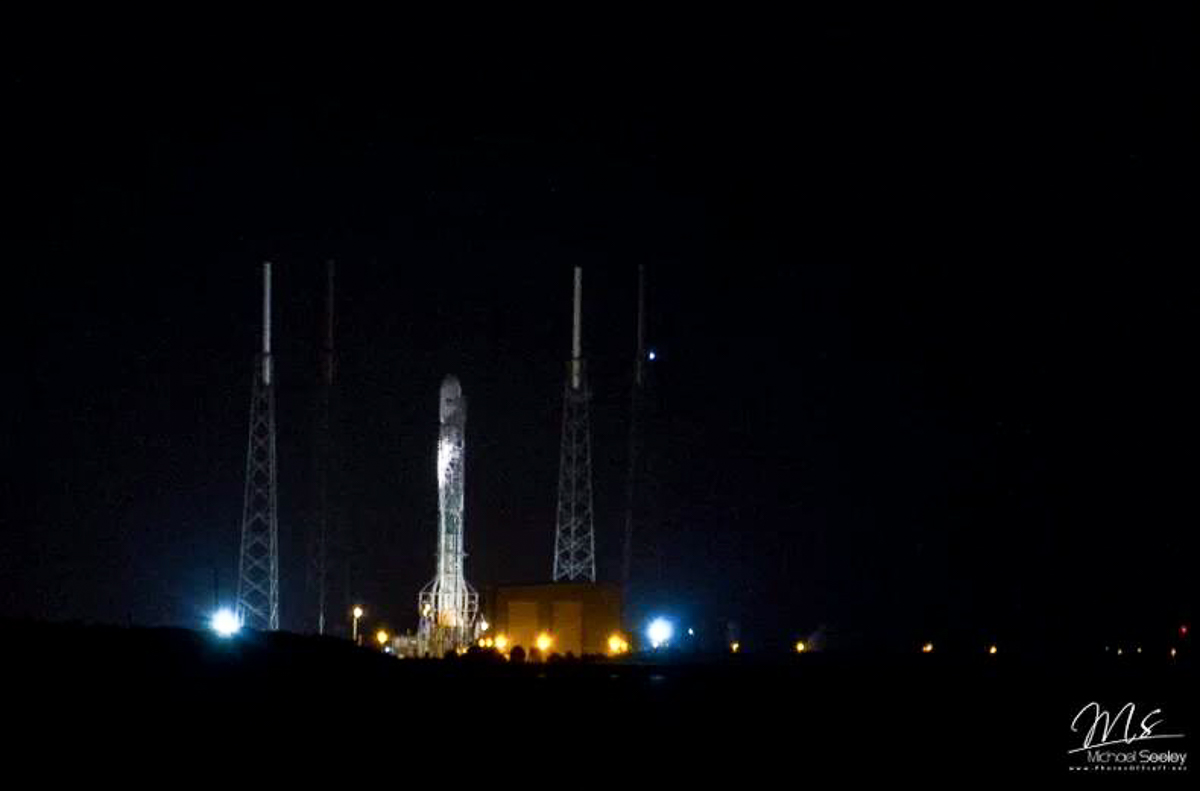
Like rolling thunder across the marshy landscape of Cape Canaveral Air Force Station, Fla., SpaceX heralded the long-awaited Return to Flight (RTF) of its Falcon-9 booster this evening (Friday, 18 December), by conducting a brief Static Test Fire of the rocket’s nine Merlin 1D+ first-stage engines. Mounted at the Cape’s storied Space Launch Complex (SLC)-40, the Falcon 9—which has supported five successful missions to Geostationary Transfer Orbit (GTO), low-Earth orbit and, for the first time, to the L1 Lagrange Point, earlier in 2015—has made a remarkable recovery in the six months since 28 June’s catastrophic loss of the Commercial Resupply Services (CRS)-7 Dragon cargo ship.
The Static Test Fire was completed tonight after 48 hours of frustrating delays caused by a number of technical issues since the Falcon-9 stack was initially raised vertical on Wednesday. Having cleared this significant pre-RTF hurdle, SpaceX will press ahead with final preparations, including the Launch Readiness Review (LRR), which is expected to confirm a No Earlier Than (NET) target of Sunday evening, 20 December, about 24 hours later than originally planned.
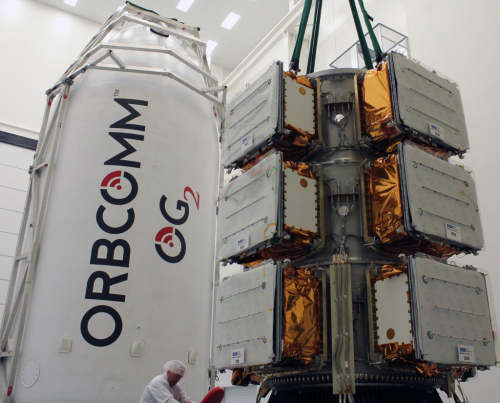
The launch was originally noted by several sources to occur within a three-hour “window” from 8:25 p.m. through 11:25 pm. EST Saturday, 19 December, but the liftoff time was subsequently narrowed to somewhere inside a 60-minute period from 8-9 p.m. “The back and forth was for an approximate liftoff time (between 8-9 p.m.),” SpaceX told AmericaSpace on Thursday. “The exact window will be shorter than 3 hours.”
Orbcomm’s website now notes a target liftoff time of 8:29 p.m. EST. The mission will boost 11 Orbcomm Generation-2 (OG-2) satellites into low-Earth orbit.
As outlined in a previous AmericaSpace article, this mission marks the maiden voyage of the “Full Thrust” (FT) variant of the rocket, also known as the “Upgraded Falcon 9”, whose nine Merlin 1D+ first-stage engines are expected to deliver a 33-percent performance gain over their predecessors. This will be achieved by running the engines at 100-percent rated thrust, as opposed to the approximately 80-percent thrust previously used, together with structural enhancements—such as increased tank volumes, a lengthened second stage and an improved “Octaweb” support structure for the first-stage powerplants—and the “densification” of the liquid oxygen load (which SpaceX CEO Elon Musk described as “deep cryo oxygen”) to meet an extra 13 percent of performance.
This densification process has also required the installation of specialized cooling stations at SLC-40. All told, the new Falcon-9 is 5.6 feet (1.6 meters) taller than its earlier incarnation, rising to 229.6 feet (70 meters).
Current predictions for a weekend launch attempt call for partly cloudy conditions, with a 20-percent probability of rain. However, it has been noted by the 45th Weather Squadron at Patrick Air Force Base that a 90-percent probability of acceptable conditions is expected, tempered by the risk of an infringement of the Cumulus Cloud Rule. Following the expected passage of a cold front to the south of the Space Coast, it was predicted that winds would remain gusty on Saturday, before weakening on Sunday. This would create “a slight risk for a coastal shower” and thus an associated Cumulus Cloud Rule violation risk.
Weather conditions for subsequent attempts into next week are expected to deteriorate with, “significant clouds, rain showers and isolated thunderstorms as well as gusty southeasterly winds.” This is expected to translate into a 60-percent probability of acceptable weather conditions for a Tuesday launch attempt.
Like the previous six OG-2 satellites, launched atop a Falcon 9 back in July 2014, the 11-strong complement assigned to Sunday’s mission will be affixed to a “stack” of Evolvable Expendable Launch Vehicle (EELV) Secondary Payload Adapter (ESPA) “rings”, encapsulated within the booster’s bulbous payload fairing. Built by East Aurora, N.Y.-headquartered Moog, Inc. Space and Defense Group, each ESPA ring carries the capability to deliver up to six secondary satellites, weighing up to 400 pounds (180 kg) apiece, to ride alongside a principal payload. Three ESPA rings, delivered to Cape Canaveral Air Force Station in late October, will be employed to carry the 11 OG-2 satellites into low-Earth orbit. The satellites themselves—each weighing 380 pounds (172 kg)—completed a Pre-Ship Review in October, before prime contractor Sierra Nevada Corp. of Sparks, Nev., transported them to the Cape for final pre-launch processing. “All satellites fully fueled and attached to the rings,” tweeted Orbcomm CEO Marc Eisenberg on 9 December. “Waiting on SpaceX to confirm launch date.”

The wait for confirmation was not a long one, with SpaceX CEO Elon Musk tweeting on 10 December: “Aiming for Falcon rocket static fire at Cape Canaveral on the 16th and launch about three days later”. Following the official announcement of a No Earlier Than (NET) launch date of 19 December, Orbcomm subsequently confirmed on Monday that the satellites and their ESPA rings have been sealed within the Falcon 9 Payload Fairing (PLF). “We’re encapsulated!” exulted Mr. Eisenberg, sharing an image of the three loaded ESPA rings alongside the bulbous PLF. Orbcomm subsequently confirmed that “SpaceX has integrated the two stages of the Falcon 9 rocket” and that “the encapsulated fairing is targeted to be mated to the Falcon 9 early tomorrow (Tuesday, December 15).”
The completion of each of these successive milestones led to today’s Static Test Fire of the nine Merlin 1D+ engines, with the Falcon 9 confirmed to be vertical on SLC-40 by the mid-afternoon Wednesday. However, the long-awaited test did not occur that day, although little explanation or detail emerged from either SpaceX or Orbcomm.
“SpaceX had a good run through of pad operations,” Orbcomm noted on Thursday, 17 December, “and is looking to static fire Falcon-9 this afternoon.” By mid-afternoon Thursday, SpaceX CEO Elon Musk tweeted on RTF progress: “Working towards static fire. Deep cryo liquid oxygen presenting some challenges.”
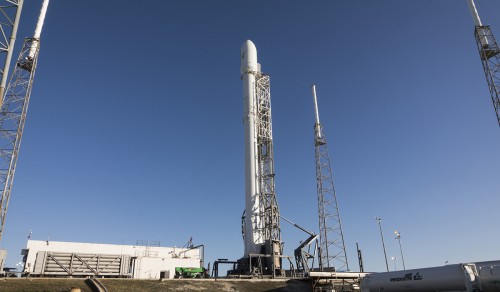
As of Friday morning, Orbcomm explained, the vehicle remained vertical on the pad, as teams continued “working towards a static fire today” to verify its readiness “and aim towards launching a few days after the static fire is completed”. The prospect of a successful Static Test Fire seemed to brighten, with Musk noting in the early afternoon that SpaceX came within 5 minutes of conducting the test, only to suffer an abort, “triggered by flight computer on upper stage throttle valve”.
He added that SpaceX engineers were “adjusting thresholds and restarting count at T-10 minutes”. A second attempt on Friday came within 2 minutes of ignition, when it too was frustrated “due to slow ground side valve”. The ignition sequence was adjusted, Musk explained, by 0.6 seconds for a third attempt. That third attempt appeared to go well. “Static fire test looks good,” Mr. Musk tweeted at 7:09 p.m. EST. “Pending data review, will aim to launch Sunday.”
The successful conclusion of the Static Fire Test is expected to be followed by the LRR. According to SpaceX, the occurrence of the LRR is dependent on the static test fire completion, and “typically happens on L-1 for commercial missions”.
As outlined in a recent AmericaSpace article, the Air Force confirmed that SpaceX, at least at the time, was awaiting Federal Aviation Administration (FAA) approval to attempt to land its Falcon-9 first-stage hardware on solid ground with the RTF booster, rather than aboard the deck of the Autonomous Spaceport Drone Ship (ASDS) in the Atlantic Ocean. The 45th Space Wing at Patrick Air Force Base signed a five-year lease with SpaceX earlier in 2015 to create a “Landing Pad” at the Cape’s historic Launch Complex (LC)-13. Utilized for Atlas Intercontinental Ballistic Missile (ICBM) tests and operational Atlas launches from August 1958 through April 1978, LC-13 was deactivated in 1980. More than three decades passed before SpaceX leased it last Feb., and efforts to construct five landing pads for its returning Falcon 9 first-stage hardware got underway. The site is now designated “Landing Complex-1”.
“Future missions will be a combination of both drone ship landings and land landings,” a SpaceX spokesperson told AmericaSpace. “The primary factor there is available vehicle performance—payloads with higher performance requirements mean the first stage will land on the drone ship, lower requirements and first stage will land on land.”
Although the OG-2 payload is a lower-performance ascent, it would appear that the ASDS “Of Course I Still Love You” was in the process of being deployed from Port of Jacksonville by the tug Elsbeth III on Wednesday afternoon, raising the probability that the Falcon-9 first stage will perform an offshore landing, as has already been trialed with mixed success on several occasions. SpaceX has proven they can hit the bulls-eye, more than once, now they just need to stabilize the booster when it hits the ground (or barge).
However, no landing plans have been released by SpaceX yet as to whether the OG-2 first-stage will attempt an oceanic ASDS landing or a touchdown on solid ground, although SpaceX says they will be releasing “more comprehensive plans” closer to launch.
UPDATE: On Dec 19, Elon Musk confirmed via Twitter that SpaceX will attempt to land the booster on Cape Canaveral AFS Landing Complex-1.
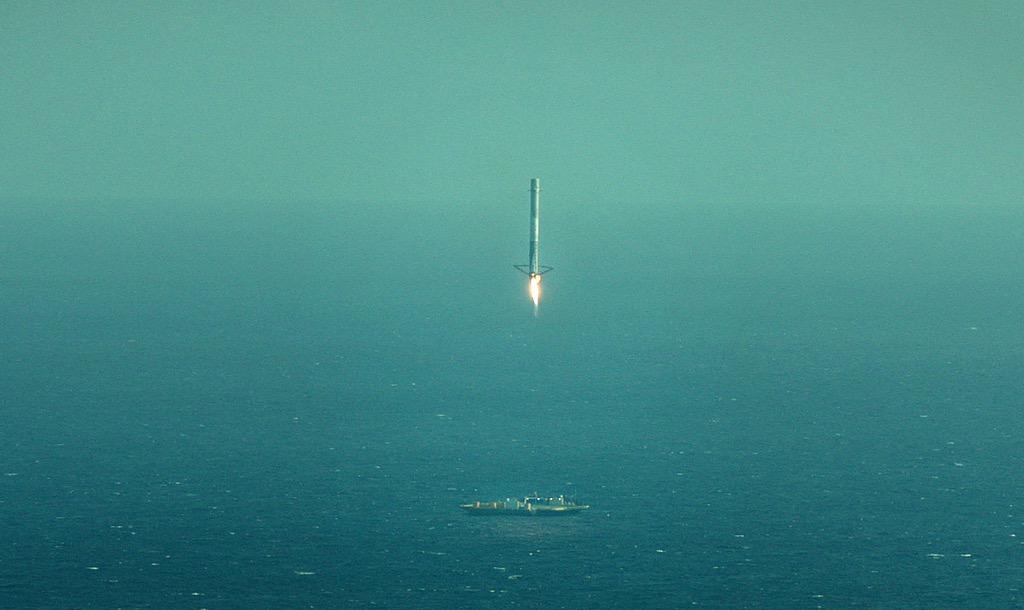
In the final hours prior to launch, Falcon-9 will be fueled with liquid oxygen and a highly refined form of rocket-grade kerosene, known as “RP-1.” The cryogenic nature of the oxygen—whose liquid state exists within a range from -221.54 degrees Celsius (-368.77 degrees Fahrenheit) to -182.96 degrees Celsius (-297.33 degrees Fahrenheit)—requires the fuel lines of the engines to be chilled, in order to avoid thermally shocking and potentially fracturing them. All propellants should be fully loaded within one hour, and the countdown will reach its final “Go/No-Go” polling point of all stations at T-13 minutes. Assuming it passes through the poll of flight controllers, the Terminal Countdown will get underway at T-10 minutes.
During this phase, the Merlin 1D+ engines will be chilled, ahead of their ignition sequence. All external power utilities from the Ground Support Equipment (GSE) will be disconnected and the roughly 90-second process of retracting the “strongback” from the vehicle will get underway. The Flight Termination System (FTS)—which is tasked with destroying the Falcon 9 in the event of a major accident during ascent—will be placed onto internal power and armed. By T-2 minutes and 15 seconds, the first stage’s propellant tanks will attain flight pressure. The Merlin 1D+s will be purged with gaseous nitrogen, and, at T-60 seconds, the SLC-40 complex’s “Niagara” deluge system of 53 nozzles will be activated, flooding the pad surface and flame trench with 30,000 gallons (113,500 liters) of water per minute to suppress acoustic energy radiating from the engine exhausts.
At T-3 seconds, the nine Merlins will roar to life. Following computer-commanded health checks, the stack will be released from SLC-40. Immediately after clearing the tower, the booster will execute a combined pitch, roll, and yaw program maneuver, which is designed to establish it onto the proper flight azimuth to inject OG-2 into orbit. Eighty seconds into the uphill climb, the vehicle will exceed the speed of sound and experience a period of maximum aerodynamic duress—colloquially dubbed “Max Q”—on its airframe. At about this time, the Merlin 1D+ Vacuum engine of the second stage will undergo a chill-down protocol, ahead of its own ignition later in the ascent. Two of the first-stage engines will throttle back, under computer command, in order to reduce the rate of acceleration at the point of Main Engine Cutoff (MECO).
Finally, at T+2 minutes and 58 seconds, the seven remaining engines will shut down and, a few seconds later, the first stage will separate from the rapidly ascending stack, at which point the booster will go into landing mode, and the turn will then come for the restartable second stage, whose Merlin 1D+ Vacuum engine will come to life to continue boosting the OG-2 stack into orbit.
.
Be sure to “Like” AmericaSpace on Facebook and follow us on Twitter: @AmericaSpace
.
Missions » Commercial Space » ORBCOMM » SpaceX OG2 M2 »



